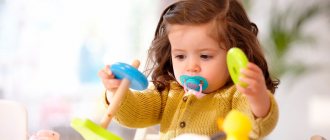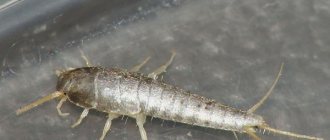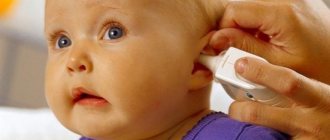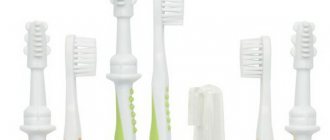Excellent health, absence of skin problems, good immunity in a newborn depends on whether the mother can properly carry out hygiene procedures.
Newborn hygiene is a necessary, daily stage of baby care, which includes several mandatory procedures.
If you do not maintain the cleanliness of a newborn’s body, then health and skin problems will certainly arise, which will have to be solved with the help of a doctor and medications. It is necessary to constantly care for your baby's skin; some procedures need to be carried out in the morning, others throughout the day.
Daily hygiene of a newborn
Newborn hygiene
Regularly performed washing and rinsing greatly increases the baby's body's resistance to infection and can be considered as a preventative measure for many colds.
The baby's morning toilet is performed daily. Children in the first months of life have different attitudes towards hygiene procedures. Some scream shrilly, others are calm, others are in an elevated emotional state.
In many ways, the reaction to hygienic “manipulations” depends on the attitude with which you care for the child. If from the very first days hygiene procedures were accompanied by affectionate speech, then by the age of three months the baby, as a rule, gets used to them and even smiles. By 6 months, the elements of care usually do not cause negative emotions, but only bring joy.
Facial care for a newborn baby
In the first two months, the baby’s face is washed with boiled water. After washing your hands well, use a sterile cotton swab dipped in warm boiled water to wipe the baby’s face, neck, ears (but not the ear canal) and the baby’s hands, after which everything is blotted with a clean soft towel. At the end of the newborn period (after 1 month), the child is washed in the morning and evening, and also as needed. At the age of 1-2 months, this procedure is carried out at least twice a day. From 4-5 months you can wash your baby with tap water at room temperature.
Newborn baby eye care
1.
The eyes can only be cleaned by moving from the outer corner inward (towards the nose). To do this, you need to take a clean, damp washcloth, a damp piece of cotton wool or a paper napkin.
2.
Each eye is washed with a separate cotton swab soaked in warm boiled water, in the direction from the outer corner of the eye to the inner, then the face is dried with clean napkins. On the recommendation of your pediatrician, you can use a solution of furatsilin 1:5000 for eye care. It is not recommended to use tea leaves!
3.
With extreme cold or inflammation of the connective tissue, the eyelashes may stick together. Place two pieces of cotton wool soaked in warm water on your closed eyes. After a short time the adhesion will be eliminated. However, you should still see a doctor.
Caring for a newborn baby's nose
Each nasal passage is cleaned separately with a cotton swab moistened with sterilized vegetable oil or special baby oil sold in a pharmacy. The flagellum is carefully moved inside the nasal passages by rotational movements by 1.0 - 1.5 cm; the right and left nasal passages are cleaned with separate flagella. This manipulation should not be carried out for too long. It is strictly forbidden to use dense objects (sticks, matches, tweezers, hairpins) with rolled cotton wool.
Caring for a newborn baby's ears
Ears can only be cleaned in the auricle with a damp washcloth. Cotton sticks are prohibited because the risk of injury from them is very high. The inner ear cleans itself. You can only carefully remove the ear fat visible from the outside with a piece of paper rolled up into a bag.
The external auditory canals are rarely cleaned; they are wiped with dry or slightly moistened with sterile vegetable oil with cotton wool. If crusts form behind the baby’s ears (which often happens), they are lubricated with baby cream or oil, since they are easily washed off during bathing.
Oral care for a newborn baby
It is not recommended to treat the oral mucosa of a healthy child due to the risk of injury. In order to examine the cavity of the baby's mouth, you need to lightly press the chin and try to open the mouth. If a white coating in the form of semolina forms on the mucous membrane of the mouth (thrush), then after each feeding the oral mucosa should be lubricated with brown flour in glycerin or moistened with a 1-2% solution of baking soda. It is not recommended to remove plaque, as it can injure the mucous membrane. To prevent thrush, you should keep your mother's hands and breasts, dishes and bottles, toys and linen clean.
Newborn baby nail care
Some babies, especially if they have been a little post-term, are born with rather long fingernails. These nails are still too soft and cannot be cut off - they will peel off on their own. However, if you do not want to see traces of scratches on the baby’s face, then the nails need to be dulled in the first days.
Newborn babies have tiny fingernails and toenails. However, although they are very soft, a child may scratch their face with them. Therefore, the child's nails should be carefully trimmed. You can either file your nails with a nail file or use nail clippers or scissors that are specifically designed for babies.
1.
The child's nails should be cut short as they grow, using small scissors with rounded ends. Before carrying out this procedure, it is necessary to treat the cutting part of the scissors with alcohol. It is recommended to trim the nails on the arms in a rounded manner, and on the legs - straight.
2.
Take your baby on your lap and hold him so that he cannot flounder or grab the scissors. Then hold the child's hand or foot firmly in your hand and trim the nails into a semicircle with small scissors (available at the pharmacy). It is easier to do this if the child is distracted by his father, siblings or interesting appearances, or during feeding.
3.
The best time to cut your child's nails is when he is sleeping. Gently pull the pad of each finger away from the nail to avoid accidentally cutting your child's finger. If you do cut it and it starts to bleed (which seems like the biggest worry!), simply squeeze the cut lightly and apply a little antibiotic ointment.
You might be surprised at how quickly your baby's nails grow; You will probably have to cut your child's toenails once or twice a month, and his fingernails once or twice a week.
Caring for the umbilical wound of a newborn baby
Until the umbilical wound has healed, it requires careful care, as it can serve as an entry point for infection. To carry out the procedure, you need to thoroughly wash your hands with soap, stretch the edges of the umbilical wound well with the thumb and forefinger of your left hand, and with your right hand, drop 1-2% brilliant green onto the wound from a pipette. Then treat the skin around the umbilical wound with cotton wool soaked in 70% alcohol (if it is not available, use brilliant green), in the direction from the center to the periphery.
Washing a newborn baby
After each bowel movement, the child should be washed from front to back in warm running water, dried with a napkin and lubricated the inguinal and buttock folds with sterile vegetable oil or other oil sold in a pharmacy, or use children's cosmetics recommended by your pediatrician. For severe contamination, use neutral baby soap. Children should not be washed with running water, for example in a basin.
After washing, the baby is placed on the changing table and the skin is blotted with a clean diaper. Then the skin folds are lubricated with a sterile cotton swab.
Giving a hygienic bath to an infant
Target:
- maintaining body hygiene;
- ensuring the child’s universal need to “be clean”;
- developing cleanliness skills;
- hardening the child.
Indications:
- proper hygienic care of a child's skin.
Contraindications:
- increased body temperature;
- child's illness;
- violation of the integrity of the skin.
Equipment:
- Bath for bathing;
- Bath diaper;
- Water jug;
- Water thermometer;
- Terry or flannel mitten;
- Baby soap or bottle with 5% solution of potassium permanganate;
- Large terry towel;
- A clean changing kit or clothes placed on the changing table;
- Sterile vegetable oil or baby powder;
- Latex gloves;
- Disinfectant solution, rags;
- Bag for dirty laundry.
Required conditions:
- The first hygienic bath should be carried out after the umbilical wound has healed;
- Do not bathe immediately after feeding;
- When swimming, ensure the room temperature is 22-24 C;
- Determine the temperature of the water for swimming only using a thermometer (it is not allowed to determine the water temperature by immersing your elbow in the water).
Performing the procedure:
- Explain to the mother the purpose and progress of the procedure;
- Prepare the necessary equipment;
- Place the bath in a stable position;
- Wash and dry your hands, put on gloves;
- Treat the inner surface of the bath with a disinfectant solution;
- Wash the bath with a brush, rinse with boiling water;
- Wipe the changing table with a disinfectant solution and place a diaper on it; Remove gloves, wash and dry hands.
- Place a folded diaper on the bottom of the bath in several layers (the edges of the diaper should not touch the side walls of the bath);
- Place a water thermometer in the bath;
- Fill the bath with water to ½ or 1/3 T 36-37 C.
Note:
a) when filling the bath with water, alternate cold and hot water;
b) control the water temperature only using a thermometer;
11. Fill a jug with water from the bath to rinse the child;
12. Undress the child (if necessary, wash under running water);
13. Throw clothes into dirty laundry bags;
14. Take the child in your arms, supporting the back and back of the head, right buttock and thighs with one hand;
15. Slowly immerse the baby in the water (first the legs and buttocks, then the upper half of the body). The water should reach the baby's nipple line, leaving the upper part of the breast open;
16. Release your right hand, continuing to support the child’s head and upper half of the body with your left;
17. Put a “mitten” on your free hand (if necessary, soap it with baby soap) and wash the child in the following sequence: head (from the forehead to the back of the head) neck torso limbs (rinse the natural folds of the skin especially thoroughly). Lastly, wash the genitals and intergluteal area;
18. Turn the child face down;
19. Rinse the baby with water from a jug (the water has cooled to 35-36 C);
Note: It is advisable to have an assistant.
20. Throwing a towel on, place the baby on the changing table;
21. Dry the skin with blotting movements.
Completing the procedure:
- Treat the natural folds of the skin with sterile vegetable oil or baby powder;
- Dress the baby and put him to bed;
- Place the diaper from the changing table and the “mitten” in a bag for dirty laundry (the mitten must be attached);
- Drain the water from the bath and rinse it;
- Wear gloves;
- Treat the inner surface of the bathtub and the working surface of the changing table with a disinfectant solution;
- Remove gloves, wash and dry hands.
Umbilical toilet
Target:
- prevent infection of the umbilical wound;
- contribute to the reduction of the umbilical wound and its scarring.
Indications:
- ensuring proper daily care of the newborn;
- loss of the umbilical cord;
- the presence of a non-epithelialized umbilical wound.
Contraindications: no
Equipment:
1. sterile cotton swabs;
2. tray for waste material;
3. 3% hydrogen peroxide solution;
4. 70% ethyl alcohol;
- brilliant green solution;
- sterile pipette;
- changing kit prepared on the changing table;
- latex gloves;
- container with disinfectant solution, rags.
Required conditions:
When treating the umbilical wound, be sure to stretch its edges (even if a crust has formed).
Safety precautions: Do not leave your baby unattended on the changing table.
Possible problems: child anxiety, bleeding of the wound, serous or purulent discharge, hyperemia of the skin around the wound.
| Stages | Rationale |
| Preparation for manipulation | |
| 1.Explain to the mother the purpose and progress of the manipulation and obtain her consent | Mother's right to information |
| 2. Prepare the necessary equipment | Ensuring accuracy and speed of manipulation |
| 3.Wash and dry your hands, put on gloves. Treat the changing table with a disinfectant solution and lay a diaper on it. Remove gloves, wash and dry hands, treat hands with antiseptic | Ensuring infection safety |
| 4.Place the baby on the changing table | The most comfortable position for the child |
| Performing a manipulation | |
| 1. Stretch the edges of the umbilical wound well with the index finger and thumb of your left hand. Note: if it is impossible to open the umbilical wound due to the presence of a dried crust, generously moisten the wound with a swab with a 3% solution of hydrogen peroxide or sterile vegetable oil and leave for a while (can be until the next swaddling.) | Ensuring maximum access to the umbilical wound |
| 2.Drop 1-2 drops of a 3% hydrogen peroxide solution from a pipette into the wound. Remove the “foam” that has formed in the wound with a sterile cotton swab, moving from inside to outside (throw the stick into the tray) | Achieving mechanical cleansing of the umbilical wound |
| 3.Keeping the edges of the umbilical wound stretched, treat it with a sterile cotton swab moistened with 70% ethyl alcohol, moving from inside to outside (drop the stick into the tray) | Providing a disinfecting and drying effect. Treatment with movements from the inside out or from the center to the periphery prevents infection from entering the umbilical wound |
| 4. Treat the skin around the wound with ethyl alcohol using a cotton swab, moving from the center to the periphery (drop the stick into the tray) | Preventing the spread of infection to surrounding tissues |
| 5. Treat (if necessary) the umbilical wound (without touching the skin around the wound) with a solution of brilliant green using a cotton swab (drop the stick into the tray) | Providing a disinfecting and drying effect. a “strong” solution of potassium permanganate can cause skin burns |
| Completion of manipulation | |
| 1.Place the baby in the crib on its side. Wash and dry your hands. | Ensuring the safety of the child |
| 2. Wear gloves. Remove the diaper from the changing table and place it in the laundry bag. Wipe the working surface of the changing table with a disinfectant solution. Remove gloves, wash and dry hands | Ensuring infection safety |
Feeding a baby
2







